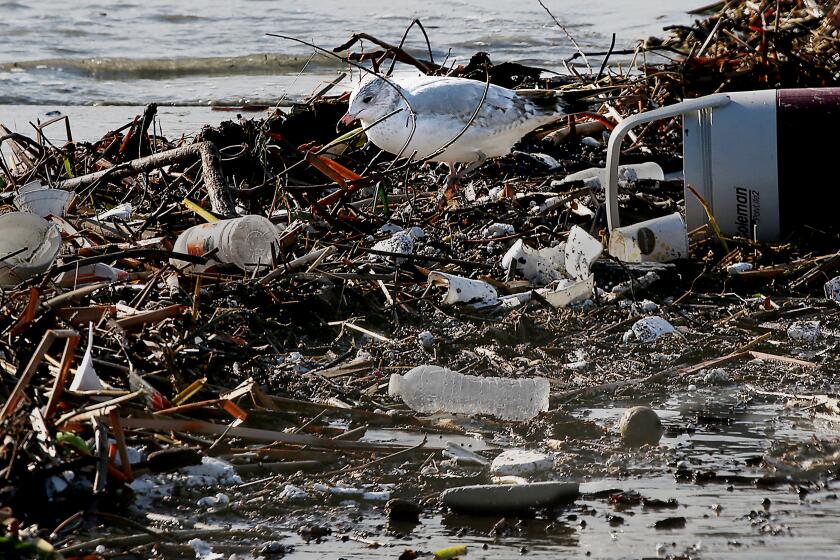Editorial: Balloon bans are the result of humans acting irresponsibly with their stuff

- Share via
Balloons can be a real menace, and not just those that may have been deployed by China to spy on the United States. Even the child-size pink plastic “Happy Birthday” balloon can be hazardous if left in the wrong hands. Or, more precisely, left from the wrong hands.
That’s because many of these innocuous party favors are filled with helium for loft and then released, either intentionally or by accident, to float gracefully away. Which they do — until they deflate and return to Earth, coming to rest in a bush or tree or plopping down into the ocean, where they may cross the path of some unfortunate sea creature.
Sadly, this is not a rare occurrence. There are several recent cases of sea turtles, seals and sea lions off the California coast discovered entangled in or choked by balloon strings, or in physical distress after ingesting balloons. Among the key findings of a 2020 Oceana report on ocean plastic was that balloons were one of the most common types of plastics entangling or consumed by marine life, along with bags, recreational fishing line, sheeting and food wrappers.
The threat to sea life is one of the main reasons a handful of coastal Southern California cities have slapped restrictions on the use of balloons, ranging from prohibiting the sale or release of lighter-than-air balloons (which generally means those filled with helium) to a ban on the sale, distribution or public use of all balloons passed by Laguna Beach on Tuesday.
Even as California passes new laws to reduce single-use plastic trash, new sources of plastic are quickly filling the void. It’s time to shift focus.
If this trend sounds familiar, that’s because a few years back it was single-use plastic straws that were targeted by local bans. Eventually, there were so many different rules about distribution of plastic disposable straws that a statewide law, beginning in 2019, made sense. Balloons may be heading for the same fate.
It didn’t have to be like this. Balloons, like plastic straws, aren’t inherently bad. The problem is how humans use and thoughtlessly dispose of them. Releasing hundreds of colorful helium-filled balloons into the sky may be a visually stunning way to mark a notable occasion, but those airborne pieces of plastic will land somewhere and subsequently become a blight on the landscape and a hazard to the local wildlife. Some states, such as Hawaii, ban the intentional mass release of all helium-filled balloons (California only restricts mylar balloon releases as part of a public or private event or promotion) or are considering bans. But accidental releases — the child letting go of the party balloon, a bouquet of celebratory balloons coming untied in the wind — are a problem too, simply because of the number of balloons let into the environment and plastic accumulation over time.
California will phase out mylar balloons by 2031 because their metallic nylon foil shells have a tendency to cause blackouts and spark wildfires when they float into power lines. That’s good, but now California legislators should consider placing restrictions on the use and release of latex balloons. The balloon industry markets latex rubber balloons as biodegradable, but studies have found that they don’t break down in the ocean. Furthermore, the strings attached to balloons are generally plastic. This makes them single-use trash in the same way that grocery bags and straws are, and releasing them into the environment is littering.
Rich German, a Laguna Beach environmentalist and founder of Project O who proposed and pushed his city’s balloon ban, acknowledges balloons aren’t the only threat to the ocean. But he sees them as symbolic of the bigger problem of plastic trash, fishing lines and gear left in the sea to endanger the animals that call it home. He hopes that the bans will inspire humans to “rethink the way we look at plastic. When people say they throw things away — there’s really no away. There’s no such thing.”
He’s right. And until humans start realizing that, balloon and straw bans are the inevitable result.
More to Read
A cure for the common opinion
Get thought-provoking perspectives with our weekly newsletter.
You may occasionally receive promotional content from the Los Angeles Times.











